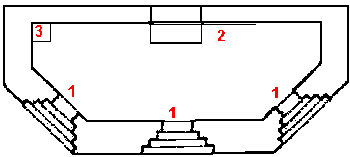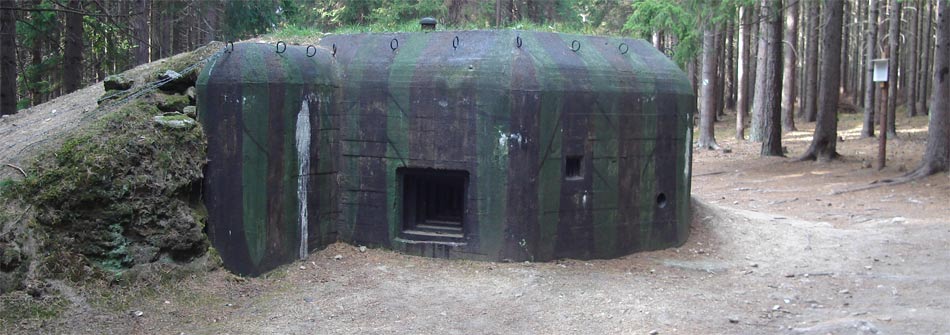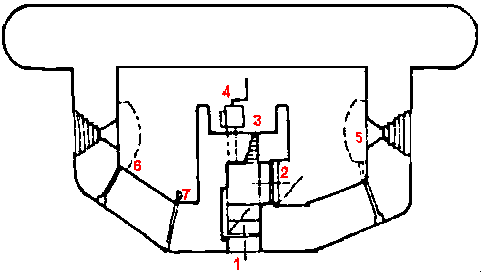
Light forts were built to protect the main line of heavy forts against a surprise enemy attack and to stop the attack until the main line of the fortification system was ready to strike against the approaching enemy or until the mobile forces of the army reached the area. They were also built in areas where an enemy tank attack wasn't viable. They were constructed to stop the enemy for a few hours (vz.36) or a few days (vz.37).
The early types named vz.36 were only copies of similar French objects. They have from one to three embrasures for machine guns. These embrasures are situated in the front of the object, so they could be easily destroyed by the fire of enemy guns. On the other hand, they have a good view towards the border, important roads or railroads, and other strategic locations. These forts weren't built in lines like vz.37, but were built separately or in very short lines to protect a part of an important road, for example.
There are four variations of this type - A, B, C and E. Types A and B have two embrasures for machine guns vz.26, type C has three embrasures and type E has only one. The entrance to these objects are closed by steel doors. The embrasure for the machine gun is closed by a 20mm thick armored cover. Type A has a 50 cm thick reinforced concrete ceiling, the wall with the embrasure for machine gun is also 50 cm thick. Side of nape is 20 cm thick. Type B and C have stronger walls -ceiling 50 cm, wall with weapon 60 cm, side of nape 30 cm. The crew of these forts consisted of 4-6 men.
 |
|---|
| light fort vz.36A number 123 by the road from Náchod (Nachod) to Broumov |

The Czechoslovakian army command needed a better type of light fort, so the ingeneers designed a new type called vz.37. This type is in fact a miniature heavy object. These forts were built mainly in chains (one to three chains) in locations where enemy tank attack was impossible. They were also built between the heavy forts to defend areas which couldn't be covered by weapons of the heavy forts. There were plans to build some for a redoubt in the interior and for the defence of Prague, but only few of these planned were built. The Czechs called and still call these types "řopík (ropik)", because ŘOP (ROP) -Ředitelství opevňovacích prací (Command for fortification works) cooperated construction of all forts.
There are also various variations of this type. Most common is vz.37A (85% of all light forts built). This fort has two
embrasures for a machine gun designed for the flank fire to left and right. It was the biggest advantage of this type in compare
with the old vz.36. The side towards the enemy is 80 cm thick and it is often faced with stones (about 1 m thick) and covered
with earth. Grass was planted on top, so the fort seemed to be a small hill. This was common for all variations of this type
except vz.37 C and E and for all heavy forts. The ceiling and the wall with the embrasure is 60 cm thick. Side of nape is 50 cm
thick. In some places the forts were built with walls thicker or thinner than these standards. The forts were equipped with
periscopes (one per MG), a man-powered ventilator, entrance with bars and armored doors. There is one embrasure for a
pistol or another personal weapon for entrance protection and special pipes for dropping grenades to protect the undefended
sides. Forts vz.37A are also divided by an angle between the left and right axis of the embrasure. We distinguish several types
vz.37A -120, -140, -160, -180, -200, -220. The crews of these forts consisted of 7 men.
Another type is vz.37B. It has two embrasures - one for the flank and one for the direct fire. The thickness of walls is the
same as in vz.37A. The equipment was also almost the same. We also distinguish seveveral types vz.37B -80, -90, -100
(angle between axis of the embrasures) and B 1 (embrasure for the flank fire on the right side), B 2 (embrasure for flank fire
on the left side). The crew of these forts were also consisted of 7 men.
Vz.37D is in fact half of the type 37A, because it has only one embrasure for a MG. These forts were built mainly at the top of
the peaks, where vz.37A couldn't be built, so two forts were built - one vz37D 1 (embrasure on the right side) and one vz37D
2 (embrasure on the left side). The crew of these forts comprised 4 men.
These two types have only one embrasure designed for flanking fire (vz.37E) and for protection of the undefended areas in the fort lines (vz.37C). The thickness of the walls of vz.37C is 50 cm embrasure, 40 cm flank walls, and 20 cm side of nape; in case of vz.37E 60 cm ceiling and wall with embrasure, 50 cm flank wall and side of nape. Fort vz.37E had the same equipment as vz.37D, vz.37C had no special equipment (periscopes, etc.). One interesting fact is that vz.37C have a ceiling made of zinc only - neither concrete nor armor. The vz.37C had a 3 man crew and the vz.37E, 4 men.
Only two forts were built (one G and one H). Vz.37 F, G and K were designed for one antitank gun and vz.37H was in fact a place where one antitank gun used to be hidden.
 |
|---|
| light fort vz.37A-120 number 1049 |
 |
|---|